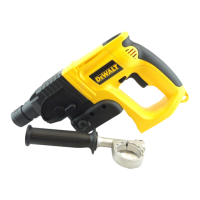7
SECTION A. SAFETY INSTRUCTIONS
flashes long, then short while in the Hot/ Cold Pack Delay mode.
REPLACE PACK:
These chargers are designed to detect certain problems that can arise with battery
packs which would be indicated by the red light flashing at a fast rate. If this occurs,
re-insert battery pack. If problem persists, try a different battery pack to determine if
the charger is OK. If the new battery charges correctly, then the original pack is
defective and should be returned to a service centre for recycling. If the new battery
pack gives the same trouble indication as the original, have the charger tested at an
Authorised Service Centre.
PROBLEM POWER LINE:
When these chargers are used with some portable power sources such as
generators or sources that convert DC to AC, the chargers may temporarily suspend
operation, flashing the red light with two fast blinks followed by a pause. This
indicates the power source is out of limits. Your power supply may need service.
LEAVING THE BATTERY PACK IN THE CHARGER
The charger and battery pack can be left connected with the red light glowing
indefinitely. The charger will keep the battery pack fresh and fully charged.
NOTE: A battery pack will slowly lose its charge when kept out of the charger. If the
battery pack has not been kept on maintenance charge, it may need to be recharged
before use. A battery pack may also slowly lose its charge if left in a charger that is
not plugged into an appropriate AC source.
IMPORTANT CHARGING NOTES
1. Longest life and best performance can be obtained if the battery pack is
charged when the air temperature is between 18°C and 24°C (65°-75°F). DO
NOT charge the battery pack in an air temperature below +4.5°C (+40°F). This is
important and will prevent serious damage to the battery pack. It is
recommended the battery pack is cycled on the tune-up mode and
the battery is left on charge for approximately 8 hours on a weekly
basis or every 10-15 charges.
2. The charger and battery pack may become warm to the touch while charging.
This is a normal condition, and does not indicate a problem.
3. If the battery pack does not charge properly - (1) Check power at receptacle by
plugging in a lamp or other appliance. (2) Check to see if receptacle is
connected to a light switch which turns power off when you turn out the lights.
(3) Move charger and battery pack to a location where the surrounding air
temperature is approximately 18° - 24°C (65°F - 75°F). (4) If charging problems
persist, take or send the tool, battery pack and charger to your local service
centre.
4. The battery pack should be recharged when it fails to produce sufficient power
on jobs which were easily done previously.
DO NOT CONTINUE to use under these conditions. Follow the charging
procedure. You may also charge a partially used pack whenever you desire
with no adverse effect on the battery pack. DO NOT FULLY DISCHARGE
THE BATTERY PACK AS THIS CAN CAUSE SEVERE DAMAGE TO
THE BATTERY PACK.
5. D
EWALT battery packs that are labelled “NiMH” should only be used with
chargers labelled “NiMH” or NiCd/ NiMH”.
6. Under certain conditions, with the charger plugged into the power supply, the
exposed charging contacts inside the charger can be shorted by foreign
material. Foreign materials of a conductive nature such as, but not limited to,
steel wool, aluminium foil, or any build up of metallic particles should be kept
away from charger activities. Always unplug the charger from the power supply
when there is no battery pack in the cavity. Unplug the charger before
attempting to clean.
7. Do not immerse charger in water or any other liquid.
8. Air Cooled batteries and chargers. Battery packs with the air cooling feature
should be removed from the tool and placed into the DE0246 charger as soon as
practical to rapidly cool the battery cells within the charger. This will assist greatly
to optimise both battery life and performance.
9. WARNING: Do not allow any liquid to get inside the charger. Electric shock
may result. To facilitate the cooling of the battery pack after use, avoid placing
the battery pack or charger in a warm environment such as a metal shed, or an
uninsulated trailer.
10. CAUTION: Never attempt to open the battery pack for any reason.
If the plastic housing of the battery pack breaks or cracks, return to an
authorised DeWALT Service Centre for recycling.

